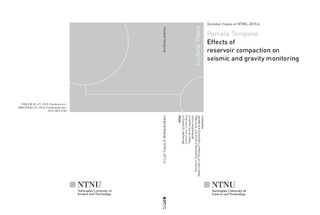| dc.contributor.author | Tempone, Pamela | nb_NO |
| dc.date.accessioned | 2014-12-19T12:14:48Z | |
| dc.date.available | 2014-12-19T12:14:48Z | |
| dc.date.created | 2011-06-07 | nb_NO |
| dc.date.issued | 2011 | nb_NO |
| dc.identifier | 421064 | nb_NO |
| dc.identifier.uri | http://hdl.handle.net/11250/239427 | |
| dc.description.abstract | The compacting reservoir embedded in a homogeneous, isotropic and elastic medium, known as Geertsma’s model, is a model commonly used in feasibility studies for forecasting time-lapse changes due to hydrocarbon production. The scope of the thesis is to include a rigid basement to Geertsma’s formulation, and to study how breaking the model symmetry affects the estimated changes in reservoir monitoring. The objective of introducing the rigid basement is to capture a general increase in rock stiffness with depth. In this way, the model narrows the gap between the analytical modelling and the effective deformation of the rocks surrounding the reservoir . The ultimate goal is to get a better estimation of the time-lapse changes expected from reservoir compaction.
An analytical solution for the displacement field caused by the compacting reservoir above a rigid basement is derived. The analytical model is introduced in a forward model for forecasting time-lapse changes in seismic monitoring and gravity monitoring. The results obtained in this way are compared with those obtained using Geertsma’s model for the same forward model.
The most visible effects of the presence of the rigid basement are the increase of subsidence and the lowering of the top reservoir. Relevance should be also given to the increase of vertical stretching in the overburden and a corresponding stretching decrease in the underburden. In the time-lapse seismic modelling, these effects result in higher time-shifts in the overburden and lower in the underburden. In the time-lapse gravity modelling, the redistribution of the rocks around the compacting reservoir above the rigid basement causes a visible change in gravity, otherwise negligible in the homogeneous half-space.
By extending Geertsma’s solution with a rigid basement below the compacting reservoir, the thesis provides a model that can reproduce the geomechanical behaviour of a subsurface where rock stiffness increases with depth. The model needs few parameters, and it can be implemented in a code that uses Geertsma’s solution. A feasibility study that includes the rigid basement model could bring interesting information to be taken into consideration in production management.
| nb_NO |
| dc.language | eng | nb_NO |
| dc.publisher | Norges teknisk-naturvitenskapelige universitet, Fakultet for ingeniørvitenskap og teknologi, Institutt for petroleumsteknologi og anvendt geofysikk | nb_NO |
| dc.relation.ispartofseries | Doktoravhandlinger ved NTNU, 1503-8181; 2011:6 | nb_NO |
| dc.relation.haspart | Tempone, Pamela; Landrø, Martin; Fjær, Erling; Inoue, Nelson. Effects on time-lapse seismic of a hard rock layer beneath a compacting reservoir. Proceedings of 2009 SPE EUROPEC/EAGE Annual Conference and Exhibition in Amsterdam - SPE 121081 4, 2009. | nb_NO |
| dc.relation.haspart | Tempone, Pamela; Landrø, Martin; Fjær, Erling. 4D gravity response of compacting reservoirs. . | nb_NO |
| dc.title | Effects of reservoir compaction on seismic and gravity monitoring | nb_NO |
| dc.type | Doctoral thesis | nb_NO |
| dc.contributor.department | Norges teknisk-naturvitenskapelige universitet, Fakultet for ingeniørvitenskap og teknologi, Institutt for petroleumsteknologi og anvendt geofysikk | nb_NO |
| dc.description.degree | PhD i petroleumsteknologi og anvendt geofysikk | nb_NO |
| dc.description.degree | PhD in Petroleum Engineering and Applied Geophysics | en_GB |

